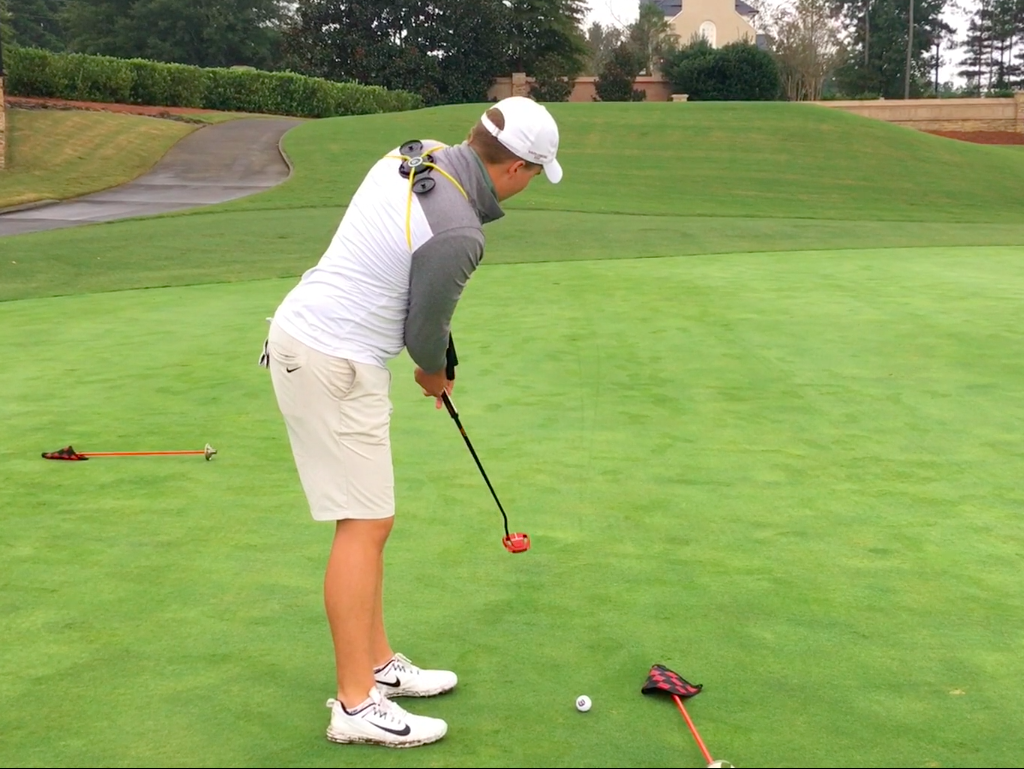Instruction
Stop Practicing, Start Training. Part 2: Putting

This article is co-written with Zach Parker. Zach is the former director of golf at the Gary Gilchrist and Bishop’s Gate golf academies. Zach is a golf coach, an expert in skill acquisition, and he has years of experience setting up effective training scenarios for golfers of varying abilities.
In Part 1 of this article, we discussed in detail how and why we should shift our focus from practicing to training. Specifically, making training more “game like” by incorporating the following three principles
- Spacing – adding time between training or learning tasks. Not hitting ball after ball with no break!
- Variability – mixing up the tasks, combining driving with chipping for example
- Challenge Point – making sure that you are firstly trying to achieve or complete a task, and secondly that the task is set an appropriate difficulty for you
For more detailed insight to this topic, check out the podcast that Zach recently recorded with Game Like Training Golf
This is with the aim of avoiding the following frustrations that occur when training is performed poorly
- Grinding on the putting green but not improving
- Being unable to transfer performance from putting green to course
- Finding practice boring
- Plateaus in performance

Practice can be frustrating
In Part 1 we covered long game, and in Part 2 it’s time to address putting. Training this crucial part of the game is often overlooked and almost always performed poorly with very little intent. On course, we never hit putts from the same distance (unless you’re in the habit of missing two footers!), yet when practicing its common to repeatedly hit putts from the same place. Our length of stroke, reaction to speed and slope and time between putts are constantly changing on course, so it would make sense to replicate that in our training right?
In the practice circuit below we have incorporated spacing by leaving large gaps between putts, variability by mixing up the tasks and challenge point by introducing hurdle tasks that must be completed before moving on to the next station.
Station 1
Learning task: Three rehearsals with a specific focus, in this case, using the GravityFit TPro to bring awareness to posture and arm-body connection.
Completion task: Must make putt from 6 feet, downhill, left to right-to-left break.
Station 2
Learning task: Three rehearsals with specific TPro focus; in this case posture for eye-line and using bands for arm-body connection.
Completion task: Must two-putt from 30-40 feet, uphill. Add drawback to five feet for more difficulty.
Station 3
Learning task: Three rehearsals with specific TPro focus again.
Completion task: Must two-putt from 20-30 ft, right to left break. Add drawback to five feet for more difficulty.
You can either have a go at this circuit or create your own. There are no set rules, just make sure to include a mixture of tasks (variability) that are appropriate to your level of ability (challenge Point) with plenty of time between repetitions (spacing).
For more information on the featured GravityFit equipment, check out the website here
- LIKE21
- LEGIT4
- WOW1
- LOL2
- IDHT1
- FLOP3
- OB5
- SHANK43
Instruction
Clement: Laid-off or perfect fade? Across-the-line or perfect draw?

Some call the image on the left laid off, but if you are hitting a fade, this could be a perfect backswing for it! Same for across the line for a draw! Stop racking your brain with perceived mistakes and simply match backswing to shot shape!
- LIKE0
- LEGIT0
- WOW0
- LOL0
- IDHT0
- FLOP0
- OB0
- SHANK1
Instruction
The Wedge Guy: The easiest-to-learn golf basic

My golf learning began with this simple fact – if you don’t have a fundamentally sound hold on the golf club, it is practically impossible for your body to execute a fundamentally sound golf swing. I’m still a big believer that the golf swing is much easier to execute if you begin with the proper hold on the club.
As you might imagine, I come into contact with hundreds of golfers of all skill levels. And it is very rare to see a good player with a bad hold on the golf club. There are some exceptions, for sure, but they are very few and very far between, and they typically have beat so many balls with their poor grip that they’ve found a way to work around it.
The reality of biophysics is that the body moves only in certain ways – and the particulars of the way you hold the golf club can totally prevent a sound swing motion that allows the club to release properly through the impact zone. The wonderful thing is that anyone can learn how to put a fundamentally sound hold on the golf club, and you can practice it anywhere your hands are not otherwise engaged, like watching TV or just sitting and relaxing.
Whether you prefer an overlap, interlock or full-finger (not baseball!) grip on the club, the same fundamentals apply. Here are the major grip faults I see most often, in the order of the frequency:
Mis-aligned hands
By this I mean that the palms of the two hands are not parallel to each other. Too many golfers have a weak left hand and strong right, or vice versa. The easiest way to learn how to hold the club with your palms aligned properly is to grip a plain wooden ruler or yardstick. It forces the hands to align properly and shows you how that feels. If you grip and re-grip a yardstick several times, then grip a club, you’ll see that the learning curve is almost immediate.
The position of the grip in the upper/left hand
I also observe many golfers who have the butt of the grip too far into the heel pad of the upper hand (the left hand for right-handed players). It’s amazing how much easier it is to release the club through the ball if even 1/4-1/2″ of the butt is beyond the left heel pad. Try this yourself to see what I mean. Swing the club freely with just your left hand and notice the difference in its release from when you hold it at the end of the grip, versus gripping down even a half inch.
To help you really understand how this works, go to the range and hit shots with your five-iron gripped down a full inch to make the club the same length as your seven-iron. You will probably see an amazing shot shape difference, and likely not see as much distance loss as you would expect.
Too much lower (right) hand on the club
It seems like almost all golfers of 8-10 handicap or higher have the club too far into the palm of the lower hand, because that feels “good” if you are trying to control the path of the clubhead to the ball. But the golf swing is not an effort to hit at the ball – it is a swing of the club. The proper hold on the club has the grip underneath the pad at the base of the fingers. This will likely feel “weak” to you — like you cannot control the club like that. EXACTLY. You should not be trying to control the club with your lower/master hand.
Gripping too tightly
Nearly all golfers hold the club too tightly, which tenses up the forearms and prevents a proper release of the club through impact. In order for the club to move back and through properly, you must feel that the club is controlled by the last three fingers of the upper hand, and the middle two fingers of the lower hand. If you engage your thumbs and forefingers in “holding” the club, the result will almost always be a grip that is too tight. Try this for yourself. Hold the club in your upper hand only, and squeeze firmly with just the last three fingers, with the forefinger and thumb off the club entirely. You have good control, but your forearms are not tense. Then begin to squeeze down with your thumb and forefinger and observe the tensing of the entire forearm. This is the way we are made, so the key to preventing tenseness in the arms is to hold the club very lightly with the “pinchers” — the thumbs and forefingers.
So, those are what I believe are the four fundamentals of a good grip. Anyone can learn them in their home or office very quickly. There is no easier way to improve your ball striking consistency and add distance than giving more attention to the way you hold the golf club.
More from the Wedge Guy
- The Wedge Guy: Golf mastery begins with your wedge game
- The Wedge Guy: Why golf is 20 times harder than brain surgery
- The Wedge Guy: Musings on the golf ball rollback
- LIKE86
- LEGIT13
- WOW6
- LOL1
- IDHT0
- FLOP4
- OB1
- SHANK8
Instruction
Clement: Stop ripping off your swing with this drill!

Not the dreaded headcover under the armpit drill! As if your body is defective and can’t function by itself! Have you seen how incredible the human machine is with all the incredible feats of agility all kinds of athletes are accomplishing? You think your body is so defective (the good Lord is laughing his head off at you) that it needs a headcover tucked under the armpit so you can swing like T-Rex?
- LIKE0
- LEGIT2
- WOW2
- LOL0
- IDHT0
- FLOP0
- OB0
- SHANK2
-

 19th Hole2 weeks ago
19th Hole2 weeks agoDave Portnoy places monstrous outright bet for the 2024 Masters
-

 19th Hole3 days ago
19th Hole3 days agoJustin Thomas on the equipment choice of Scottie Scheffler that he thinks is ‘weird’
-

 19th Hole2 weeks ago
19th Hole2 weeks agoTiger Woods arrives at 2024 Masters equipped with a putter that may surprise you
-

 19th Hole3 days ago
19th Hole3 days ago‘Absolutely crazy’ – Major champ lays into Patrick Cantlay over his decision on final hole of RBC Heritage
-

 19th Hole2 weeks ago
19th Hole2 weeks agoTwo star names reportedly blanked Jon Rahm all week at the Masters
-

 19th Hole1 week ago
19th Hole1 week agoReport: LIV Golf identifies latest star name they hope to sign to breakaway tour
-

 19th Hole1 week ago
19th Hole1 week agoNeal Shipley presser ends in awkward fashion after reporter claims Tiger handed him note on 8th fairway
-

 19th Hole1 week ago
19th Hole1 week agoBrandel Chamblee has ‘no doubt’ who started the McIlroy/LIV rumor and why


























Matthew Hamilton
Nov 26, 2018 at 3:07 pm
Nick not sure why the other comments have been so rude but I like the concept of ‘training’ not ‘practicing’ & incorporating challenges and familiar exercise concepts such as repetitions and skill level etc. Would love to get a golf specific strength and conditioning coaches take on left wrist arthritis (perhaps a possible future article?). Cheers.
Joe
Nov 20, 2018 at 2:52 pm
The first article had the sub head “Long Game” but provided putting exercises? Why? Shouldn’t the proposed exercises have been related to driver and woods?
ogo
Nov 20, 2018 at 6:14 pm
…. because Nick’s articles is not aimed at the majority of golfers who sling a pot belly and then block their hip rotation to bring the m a s s of fat under control… otherwise they would shear their lower spine… 😮
DaveNVaBeach
Nov 20, 2018 at 2:52 pm
I absolutely love running into guys like you on the golf course, I’m athletic but probably a slug by your standards. Absolutely mopping the floor with morons like you brings me more pleasure than any single other thing in golf!
ogo
Nov 20, 2018 at 6:11 pm
You are a lonely gearhead who polishes his clubs daily … and says “I love my driver.”… which you polish twice daily…. ºuº
ogo
Nov 20, 2018 at 1:34 pm
The article totally ignores the fact that most/all recreational golfers are non-athletic slugs. Before they can practice meaningfully they MUST condition their body in a gym so they have endurance and strength. Then and only then can they embark on practicing athletically. Without body conditioning all this talk about ‘practice’ is useless … even for putting.